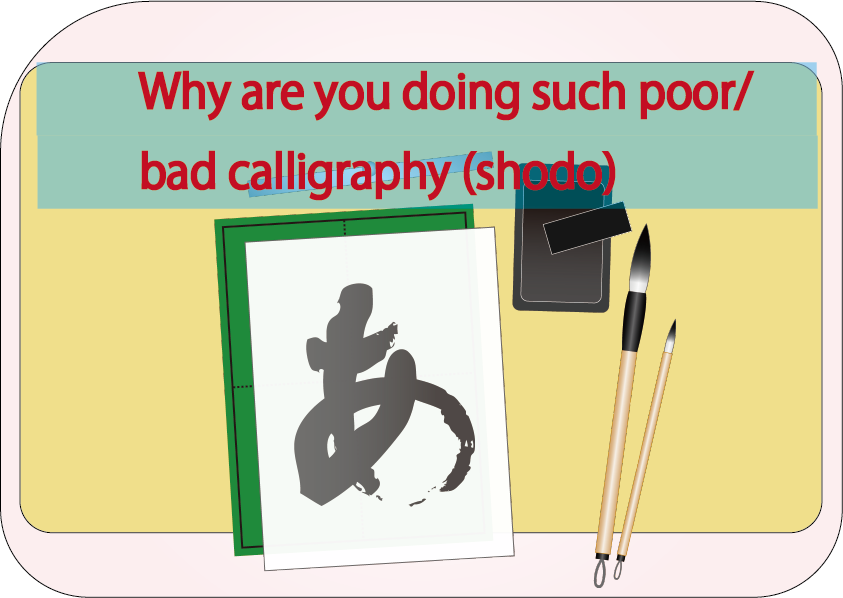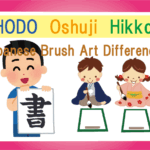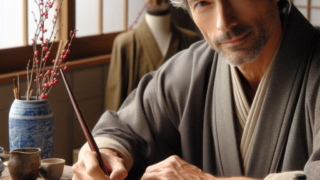目次
To Foreign Visitors to Japan:
Understanding the True Depth of SHODO Culture
A Warning to the Growing Number of Foreign Tourists Visiting Japan for SHODO
Among foreign tourists visiting Japan, the number of people coming with interest
in Zen culture and SHODO culture is rapidly increasing.
Zen experiences at temples in Kyoto and Nara, SHODO classes in Asakusa and Ginza –
many tours are organized as “traditional Japanese cultural experiences.”
However, there is something I must say loudly here.
Unfortunately, it is absolutely impossible to understand true SHODO culture
through these tourist site SHODO experiences alone.
SHODO Experience and SHODO Culture Are Worlds Apart
What most foreign tourists experience as “SHODO” is the act of being guided
by an instructor’s hand to write characters with a brush, copying examples.
Writing kanji characters like “beauty,” “love,” or “peace” on rice paper,
then framing them as souvenirs to take home.
Certainly, this might be one form of cultural experience.
However, even if you experienced SHODO in Japan,
that is merely writing characters on rice paper with ink and brush.
Thinking that you have “experienced SHODO culture” is an extremely shallow
and major misunderstanding.
SHODO culture is an extremely profound and complex artistic system
that Japanese people spend decades of their lives training in.
Its spirituality, historical background, and depth of technique are not shallow enough
to be understood through hours or days of experience.
The Reality and Limitations of Tourist SHODO Experiences
Currently, most SHODO experiences for foreigners conducted throughout Japan
are merely “entertainment” simplified for commercial purposes.
The basic posture, breathing methods, and mental concentration required
in authentic SHODO training are completely omitted.
Even just holding the brush, learning the correct grip requires
at least several years of practice.
Adjusting ink concentration, applying brush pressure to paper,
the spirituality embedded in each stroke – all of these are
essential elements of SHODO.
Consider This in Terms of Your Country’s Traditional Culture
For example, suppose your country has traditional embroidery techniques.
That embroidery has hundreds of years of history, with unique techniques
passed down through generations in specific regions.
The selection of threads, needle movements, color combinations,
and above all, the craftsman’s thoughts and prayers embedded in each stitch.
If tourists from other countries came and said they “understood” or “mastered”
such traditional techniques in a 2-hour experience class, how would you feel?
You would surely feel indignant at such shallowness.
Similarly, there are traditional techniques such as:
- French winemaking
- Italian pottery
- Indian dyeing techniques
These are not mere techniques, but condensations of the lifestyle,
values, and spirituality of those countries’ people.
Without deeply understanding a country’s historical background,
social structure, religious views, and aesthetic sense – its cultural context –
true traditional culture can never be understood.
This applies exactly the same to SHODO.
Deep Understanding of Japanese Culture Required for SHODO
To truly understand SHODO, you must first know Japanese history.
How kanji characters transmitted from China developed uniquely in Japan,
how Heian period aristocratic culture influenced the aesthetics of calligraphy.
How the introduction of Zen Buddhism brought changes to SHODO’s spirituality.
Furthermore, you must understand the following concepts of Japanese aesthetics:
- “Wabi-sabi”
- “Ma” (space/pause)
- “Beauty of empty space”
These aesthetic senses are sensibilities that Japanese people have cultivated
over long years, and cannot be acquired overnight.
The Correct Way to Approach SHODO
As Personal Enjoyment, There Is No Problem
What I don’t want you to misunderstand is that being moved by SHODO
and taking ink, brushes, and rice paper back to your country
to write characters is perfectly fine.
That is a sufficiently valuable act as personal hobby and enjoyment.
However, what’s important is the matter of recognition.
Rather than calling it “SHODO,” please treat it as merely
“the act of writing characters on paper with a brush”.
The word SHODO contains long history and deep spirituality.
Even for Japanese People, Mastery Is Extremely Difficult
What I want to emphasize here is that Zen and SHODO are by no means easy
even for Japanese people.
Even Japanese people who have been familiar with the Japanese language
since birth require extraordinary effort to master true SHODO.
Unfortunately, there are many Japanese people who practice Zen and SHODO
with incorrect interpretations, causing misunderstandings of Japanese culture
overseas or luckily winning prizes in competitions.
Seeing such people call themselves “SHODO artists” and introduce Japanese culture
overseas, I honestly feel this is a very worrying situation.
When I have opportunities to view such people’s works,
they are technically and spiritually very shallow
and mostly at levels unbearable to appreciate – this is the reality.
The brushwork is crude, character balance is broken,
and above all, no spirituality can be felt from the works.
The Seriousness of Japanese Cultural Misunderstandings Overseas
If such situations continue, understanding of Japanese SHODO culture overseas
will become further distorted.
Already in many countries, there is a tendency to regard SHODO
as merely a type of “calligraphy” or “art.”
SHODO is not simply a technique for writing beautiful characters.
It is a comprehensive art form that condenses Japanese spirituality,
philosophy, and aesthetic sense.
Imitating only superficial techniques without understanding this essence
is not an exaggeration to call blasphemy against Japanese culture.
What True SHODO Is
Why Lifelong Training Is Necessary
Zen and SHODO are arts formed through dedicating
most of one’s lifetime.
Why is such a long time necessary?
First, let me explain from the technical aspect.
Even just handling the brush, its profundity is immeasurable.
The amount of ink contained in the brush, minute adjustments of brush pressure,
brush tip movements – all of these determine the beauty of a single character.
And these techniques cannot be acquired through
intellectual understanding alone.
Through thousands and tens of thousands of repetitive practices,
they must be embedded in the hands, arms, and entire body.
However, the essence of SHODO is not technique alone.
More important is the spiritual aspect.
When writing a single character, SHODO artists completely unify their minds,
dispel distracting thoughts, and pour their entire being into that moment.
Reaching this state of mental concentration requires
years of Zen-like training.
I don’t want people to touch it lightly – this is my honest feeling
toward Japan’s important cultural heritage.
This is a stern warning not only to foreigners
but also to Japanese people with shallow thinking.
The Importance of Classical Study
To learn true SHODO, deep study of classics is indispensable.
The following great calligraphers’ works throughout history
must be thoroughly copied:
- Wang Xizhi
- Yan Zhenqing
- Kukai (Kobo Daishi)
These classical works are not mere models.
Each era’s background, the calligrapher’s life philosophy,
the social conditions of the time – all are reflected in the works.
Studying classics means understanding the entire culture of that era.
The Importance of Master-Disciple Relationships
Master-disciple relationships in Japanese SHODO are deep spiritual connections
that transcend mere technical transmission.
Masters not only teach techniques to disciples but also transmit attitudes
toward SHODO practice, life philosophy, and sensitivity to beauty.
These master-disciple relationships continue for years,
sometimes even decades.
Disciples observe their master’s every movement
and gradually understand their spirituality.
Such relationships are absolutely impossible to obtain
in short-term experience classes.
Humility in Learning from Other Countries’ Techniques
Here, I would like to consider true skill acquisition
through my personal experience.
The shock I felt when witnessing the excellence of American pinstriping techniques
is still vividly remembered.
Pinstriping is a decorative technique of drawing thin lines and letters
on automobile bodies.
It might appear simple at first glance, but actually requires
extremely advanced skills.
Pinstriping craftsmen don’t just draw lines but also create beautiful fonts
with alphabets and numbers.
Using special brushes for pinstriping unfamiliar to Japanese people,
the sight of skilled craftsmen drawing alphabets skillfully
with flowing movements without any hesitation
was truly worthy of being called art.
The certainty of brushwork, beauty of lines, and overall compositional power
were truly admirable to me as a Japanese person.
These skilled pinstriping craftsmen have undoubtedly dedicated
much of their lives to this technique.
They have probably spent decades polishing their skills and sensibility.
What I keenly realized through this experience was that regardless of country
or technique, mastering any path requires appropriate time and effort.
I also reaffirmed the importance of respecting other countries’ techniques
and maintaining a humble attitude toward learning.
This is exactly what can be said about SHODO and Zen.
True skill acquisition requires deep understanding and long-term training,
regardless of nationality.
The Reality and Problems of SHODO Education in Japan
School Education Alone Is Completely Insufficient
In Japan, from elementary through high school, SHODO and calligraphy
are incorporated as mandatory subjects.
Many foreigners assume “Japanese people can do SHODO
because they learn it in school.”
However, this is a major misunderstanding.
SHODO classes conducted in schools are only about learning basic
brush holding and fundamental character writing.
With about one hour per week for at most 12 years of study,
such experience absolutely cannot develop SHODO skills
presentable to the public.
SHODO in school education is merely experiencing the entrance to SHODO.
The true world of SHODO is an endlessly deep world beyond that.
The Problem of Casually Opening SHODO Schools
The most serious problem is the tendency for people who haven’t dedicated
sufficient life time to SHODO to casually try opening SHODO schools.
The existence of people who claim to “teach SHODO” with only school-level
knowledge and experience is very harmful to Japanese SHODO culture.
While they know superficial SHODO techniques, they have only shallow
understanding of its spiritual aspects and historical background.
Students learning from such instructors create a vicious cycle
of spreading further incorrect understanding.
Don’t you think this is extremely foolish?
Just as doctors study in medical school and undergo long-term training
before treating patients, teaching SHODO requires appropriate qualifications
and experience.
Distortion of SHODO Through Commercialism
In modern Japan, there are aspects of SHODO being swallowed
by commercialism.
Organizations exist that charge high tuition fees with the promise
of obtaining “SHODO instructor” qualifications in short periods.
These “quick SHODO schools” claim that techniques that should originally
take years to acquire can be learned in a few months.
However, what can be obtained in such short periods is only
the external form of SHODO, and its spirituality and true beauty
can never be acquired.
The Problem of Factionalism in the SHODO World
Unfortunately, problems of factionalism also exist
in Japan’s SHODO world.
Each school asserts its own theories and techniques
while tending to look down on other schools.
Such narrow-minded attitudes hinder the development
of SHODO culture as a whole.
True SHODO artists should have the humility to learn excellent techniques
and spirituality beyond school boundaries.
The important attitude is learning from classics, absorbing ancestors’ wisdom,
and applying it to modern times.
The Path of True Specialists
What kind of people are true SHODO specialists?
They finish school education and work as members of society,
yet never give up their pursuit of SHODO.
They work on weekdays and use weekends and evening hours
for classical copying practice.
They study under masters, receive strict guidance,
and gradually polish their technique and spirituality.
They submit to exhibitions, face repeated rejections,
yet continue practicing without giving up.
Continuing such steady efforts for decades, only at ages 50 or 60
do their true techniques finally bloom, and they become able
to write works they can be proud of.
This is the reality of SHODO training.
Some people show talent from a young age, but even they need
considerable years to reach true depth.
SHODO is an art pursued throughout one’s lifetime.
The Correct Path for Foreigners to Learn SHODO
The Importance of Long-term Perspective
If foreigners truly want to learn SHODO, having a long-term perspective
is essential.
Rather than periods of a few years or decades, the resolve to continue
learning throughout one’s life is necessary.
Starting with Japanese language acquisition,
the following knowledge must be obtained:
- Japanese history
- Japanese literature
- Japanese religious views
And above all, long-term residence in Japan is necessary
to physically experience Japanese lifestyle and values.
Choosing an Appropriate Master
The most important thing in learning SHODO is
meeting an appropriate master.
However, this is an extremely difficult challenge for foreigners.
True SHODO artists do not casually take disciples.
They take long time to assess character, confirm sincere will to learn,
and only then begin instruction.
Such authentic master-disciple relationships are impossible to build
through tourist SHODO experiences or short-term SHODO classes.
Finally: Respect and Humility Toward Culture
Please Don’t Be Satisfied with Superficial Experiences
What I strongly request of foreign visitors to Japan is please don’t be satisfied
with superficial cultural experiences.
Don’t think you’ve “understood Japanese SHODO” just because you held a brush
and wrote one character in a SHODO experience.
That is merely touching one drop of water
in the deep ocean that is SHODO.
The true world of SHODO has infinite depth spreading beyond that single drop.
What Does Respecting Culture Mean?
Respecting culture doesn’t mean only enjoying
the superficial parts of that culture.
It means understanding the historical background, spirituality,
and technical depth that culture possesses, and approaching it
with a humble attitude.
Foreigners who want to earnestly engage with SHODO culture should
start by deeply understanding Japanese culture as a whole.
Rather than being satisfied with short-term tourist experiences,
respect its profundity and maintain an attitude of continued learning
from a long-term perspective.
Aiming for True International Cultural Exchange
The reason I use such harsh words is definitely not because
I want to exclude foreigners.
Rather, it’s because I want to realize true international cultural exchange.
Cultural exchange based on superficial understanding ultimately
only creates misunderstandings and prejudice.
However, cultural exchange based on deep understanding can enrich
each other’s cultures and improve humanity’s overall cultural heritage.
For this, both the humility of learners and the strictness of teachers
are necessary.
Easy compromises ultimately result in degrading both cultures.
Understanding the true value of Japanese SHODO culture
and correctly transmitting it to future generations.
This is the responsibility and mission of those of us living in modern times.
I sincerely hope that foreign visitors will share this responsibility
and mission with us.
And if you become true understanders of SHODO culture in the real sense,
there would be no greater joy.






